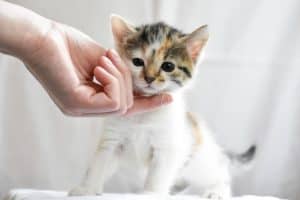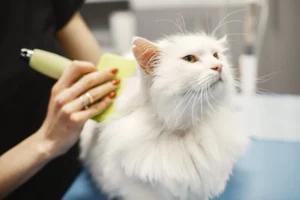Have you ever found yourself wondering, “Why does my cat hump my arm?” It can be a confusing and unexpected behavior from our feline friends. Let’s explore the reasons behind this behavior and what it might mean for your cat.
As a pet owner, it’s important to understand why your cat may exhibit this behavior. While it may seem strange or even amusing to us, there are actually several reasons why a cat may hump your arm. It’s essential to delve into these reasons to better understand our furry companions.
Instinctual Behavior
Have you ever wondered why your cat seems to have a sudden urge to hump your arm? Well, it turns out that this behavior is often rooted in their natural instincts. Mating instincts play a significant role in this behavior, as cats may exhibit humping behavior as a way to mimic the mating process.
Additionally, territory marking can also drive a cat to hump objects, including your arm. By displaying this behavior, they are claiming ownership over you or the object they are humping. It’s their way of establishing dominance and marking their territory.
Understanding these instinctual behaviors can help you better comprehend why your cat engages in this behavior. It’s essential to recognize that humping is a normal part of their instinctual repertoire, even if it can be confusing or surprising for us as pet owners.
Stress or Anxiety
If your cat is humping your arm, it might be a sign that they are experiencing stress or anxiety. Cats, like humans, can display unusual behaviors when they are feeling overwhelmed or anxious.
To help alleviate your cat’s stress or anxiety, it’s crucial to create a calm and comfortable environment for them. Providing a quiet space, plenty of toys for stimulation, and regular playtime can all help reduce their anxiety levels. Additionally, if you suspect that your cat’s humping behavior is due to stress, consider consulting with a veterinarian or animal behaviorist for further guidance.
Remember, cats communicate through their actions, and humping behavior could be their way of expressing their emotional state. By addressing the root cause of their stress or anxiety, you can help your feline friend feel more secure and content in their environment.
Lack of Socialization
When your cat humps your arm, one possible reason could be a lack of proper socialization during their formative years. Just like humans, cats need social interactions and experiences to learn appropriate behaviors. If your cat didn’t have the opportunity to interact with other cats or humans in a positive way, they may exhibit unusual behaviors like humping.
To address this issue, make sure to spend quality time with your cat, providing plenty of playtime, affection, and positive reinforcement. Encourage social interactions with other pets or people, gradually introducing them to new experiences in a safe and controlled manner. With patience and consistency, you can help your cat learn proper social behaviors and reduce the likelihood of humping in the future.
Medical Concerns
If your cat is unexpectedly humping your arm, it’s essential to consider potential medical concerns that may be causing this behavior. While humping can be a normal part of a cat’s mating behavior, excessive or sudden humping could indicate underlying health issues.
Consulting with a veterinarian is crucial to rule out any medical conditions that might be triggering this behavior. Medical reasons such as hormonal imbalances, urinary tract infections, or even neurological issues could be contributing factors. By addressing any health issues promptly, you can ensure the well-being of your furry friend and potentially alleviate the humping behavior.
Additional Unique Insight:
In some cases, spaying or neutering your cat can help reduce humping behavior, especially if it is related to mating instincts. This procedure can help regulate hormones and decrease the urge to hump. If your cat is not already spayed or neutered, discussing this option with your veterinarian can be beneficial in addressing humping behavior.
Remember, understanding the reasons behind your cat’s humping behavior is the first step in finding a solution. By considering both socialization and medical concerns, you can help your cat lead a happier and healthier life.
Attention Seeking
If your cat is humping your arm, it may be seeking attention or trying to communicate with you. Cats, like humans, have various ways of expressing their needs, and humping could be your feline friend’s way of saying, “Hey, pay attention to me!”
To address this behavior appropriately, try spending more quality time with your cat. Engage in interactive play sessions, provide enriching toys, and create a stimulating environment to keep your cat mentally and physically active. By meeting your cat’s needs for attention and stimulation, you may reduce the frequency of arm-humping episodes.
Additionally, consider setting boundaries by gently redirecting your cat’s behavior whenever it starts humping your arm. Offer a suitable alternative such as a toy or a scratching post to help redirect its energy in a positive way. Remember to reward good behavior with treats or praise to reinforce positive habits.
Behavioral Modification
If humping becomes a problem in your household, there are several tips and techniques you can try to modify your cat’s behavior effectively. First and foremost, it’s essential to rule out any underlying medical issues by consulting with your veterinarian.
One effective strategy is to provide appropriate outlets for your cat’s natural instincts, such as scratching posts, climbing trees, or puzzle feeders. These outlets can help satisfy your cat’s need for physical and mental stimulation, reducing the likelihood of humping behavior.
Moreover, consider implementing a consistent training routine to discourage humping. Use positive reinforcement techniques like clicker training or rewards to encourage desirable behaviors and discourage unwanted ones. Consistency and patience are key when modifying your cat’s behavior, so be sure to stay committed to the training process.
Additional insight: Consider using calming pheromone diffusers or sprays in your home to create a peaceful environment that may help reduce stress and anxiety, potentially decreasing the likelihood of humping behavior in your cat.
- Provide a safe and comfortable space for your cat to retreat to when feeling overwhelmed.
- Be mindful of your cat’s body language and vocal cues to better understand its emotions and needs.
- Consult with a professional animal behaviorist for personalized advice and guidance in addressing your cat’s humping behavior.
Remember, each cat is unique, so patience, consistency, and understanding are key when addressing and modifying this behavior. By taking proactive steps and addressing the root cause, you can help your cat lead a happier, more fulfilling life.
Unique Situations
In some unique cases, cats may hump your arm as a form of play or social interaction. Just like how they may knead or groom you, humping can be a way for them to engage with you and show affection. This behavior is often more common in young, energetic cats who may be exploring different ways to interact with their human companions. It’s essential to pay attention to your cat’s body language and overall behavior to determine if the humping is playful or if there are underlying issues that need to be addressed.
Another unique situation that may lead to humping behavior in cats is stress or anxiety. Cats can exhibit peculiar behaviors when they are feeling overwhelmed or anxious, and humping may be a way for them to cope with these emotions. If your cat is consistently humping your arm or other objects, it may be worth exploring ways to reduce their stress levels and create a more calming environment for them.
It’s important to remember that every cat is unique, and there may be specific reasons why your feline friend is humping your arm. By observing their behavior closely and considering any underlying factors, you can better understand and address this behavior to ensure a harmonious relationship with your pet.
Tips for Addressing Cat Humping Behavior
- Provide Mental and Physical Stimulation: Engage your cat in interactive play sessions and provide toys and scratching posts to keep them mentally and physically stimulated.
- Establish a Routine: Cats thrive on routine, so creating a consistent schedule for feeding, playtime, and rest can help reduce stress and prevent humping behavior.
- Consult with a Veterinarian: If your cat’s humping behavior is persistent and concerning, it’s essential to consult with a veterinarian to rule out any underlying medical issues or hormonal imbalances. A professional can provide guidance on potential solutions and behavior modification techniques to address the issue effectively.
By implementing these tips and considering potential underlying factors, you can work towards minimizing or resolving your cat’s humping behavior while strengthening the bond between you and your furry companion.
Alex, a passionate animal lover, has experience in training and understanding animal behavior. As a proud pet parent to two dogs and three cats, he founded AnimalReport.net to share insights from animal experts and expand his knowledge of the animal kingdom.




